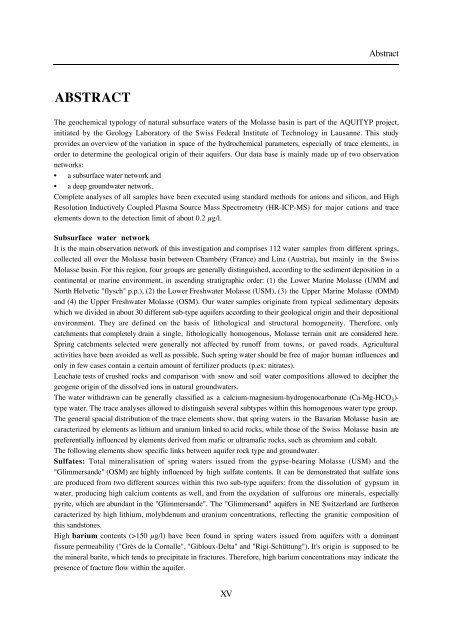typologie des eaux souterraines de la molasse entre chambéry et linz
typologie des eaux souterraines de la molasse entre chambéry et linz
typologie des eaux souterraines de la molasse entre chambéry et linz
Create successful ePaper yourself
Turn your PDF publications into a flip-book with our unique Google optimized e-Paper software.
ABSTRACT<br />
XV<br />
Abstract<br />
The geochemical typology of natural subsurface waters of the Mo<strong>la</strong>sse basin is part of the AQUITYP project,<br />
initiated by the Geology Laboratory of the Swiss Fe<strong>de</strong>ral Institute of Technology in Lausanne. This study<br />
provi<strong><strong>de</strong>s</strong> an overview of the variation in space of the hydrochemical param<strong>et</strong>ers, especially of trace elements, in<br />
or<strong>de</strong>r to <strong>de</strong>termine the geological origin of their aquifers. Our data base is mainly ma<strong>de</strong> up of two observation<br />
n<strong>et</strong>works:<br />
• a subsurface water n<strong>et</strong>work and<br />
• a <strong>de</strong>ep groundwater n<strong>et</strong>work.<br />
Compl<strong>et</strong>e analyses of all samples have been executed using standard m<strong>et</strong>hods for anions and silicon, and High<br />
Resolution Inductively Coupled P<strong>la</strong>sma Source Mass Spectrom<strong>et</strong>ry (HR-ICP-MS) for major cations and trace<br />
elements down to the <strong>de</strong>tection limit of about 0.2 µg/l.<br />
Subsurface water n<strong>et</strong>work<br />
It is the main observation n<strong>et</strong>work of this investigation and comprises 112 water samples from different springs,<br />
collected all over the Mo<strong>la</strong>sse basin b<strong>et</strong>ween Chambéry (France) and Linz (Austria), but mainly in the Swiss<br />
Mo<strong>la</strong>sse basin. For this region, four groups are generally distinguished, according to the sediment <strong>de</strong>position in a<br />
continental or marine environment, in ascending stratigraphic or<strong>de</strong>r: (1) the Lower Marine Mo<strong>la</strong>sse (UMM and<br />
North Helv<strong>et</strong>ic "flysch" p.p.), (2) the Lower Freshwater Mo<strong>la</strong>sse (USM), (3) the Upper Marine Mo<strong>la</strong>sse (OMM)<br />
and (4) the Upper Freshwater Mo<strong>la</strong>sse (OSM). Our water samples originate from typical sedimentary <strong>de</strong>posits<br />
which we divi<strong>de</strong>d in about 30 different sub-type aquifers according to their geological origin and their <strong>de</strong>positional<br />
environment. They are <strong>de</strong>fined on the basis of lithological and structural homogeneity. Therefore, only<br />
catchments that compl<strong>et</strong>ely drain a single, lithologically homogenous, Mo<strong>la</strong>sse terrain unit are consi<strong>de</strong>red here.<br />
Spring catchments selected were generally not affected by runoff from towns, or paved roads. Agricultural<br />
activities have been avoi<strong>de</strong>d as well as possible. Such spring water should be free of major human influences and<br />
only in few cases contain a certain amount of fertilizer products (p.ex: nitrates).<br />
Leachate tests of crushed rocks and comparison with snow and soil water compositions allowed to <strong>de</strong>cipher the<br />
geogene origin of the dissolved ions in natural groundwaters.<br />
The water withdrawn can be generally c<strong>la</strong>ssified as a calcium-magnesium-hydrogenocarbonate (Ca-Mg-HCO 3)type<br />
water. The trace analyses allowed to distinguish several subtypes within this homogenous water type group.<br />
The general spacial distribution of the trace elements show, that spring waters in the Bavarian Mo<strong>la</strong>sse basin are<br />
caracterized by elements as lithium and uranium linked to acid rocks, while those of the Swiss Mo<strong>la</strong>sse basin are<br />
preferentially influenced by elements <strong>de</strong>rived from mafic or ultramafic rocks, such as chromium and cobalt.<br />
The following elements show specific links b<strong>et</strong>ween aquifer rock type and groundwater.<br />
Sulfates: Total mineralisation of spring waters issued from the gypse-bearing Mo<strong>la</strong>sse (USM) and the<br />
"Glimmersan<strong>de</strong>" (OSM) are highly influenced by high sulfate contents. It can be <strong>de</strong>monstrated that sulfate ions<br />
are produced from two different sources within this two sub-type aquifers: from the dissolution of gypsum in<br />
water, producing high calcium contents as well, and from the oxydation of sulfurous ore minerals, especially<br />
pyrite, which are abundant in the "Glimmersan<strong>de</strong>". The "Glimmersand" aquifers in NE Switzer<strong>la</strong>nd are furtheron<br />
caracterized by high lithium, molyb<strong>de</strong>num and uranium concentrations, reflecting the granitic composition of<br />
this sandstones.<br />
High barium contents (>150 µg/l) have been found in spring waters issued from aquifers with a dominant<br />
fissure permeability ("Grès <strong>de</strong> <strong>la</strong> Cornalle", "Gibloux-Delta" and "Rigi-Schüttung"). It's origin is supposed to be<br />
the mineral barite, which tends to precipitate in fractures. Therefore, high barium concentrations may indicate the<br />
presence of fracture flow within the aquifer.

















